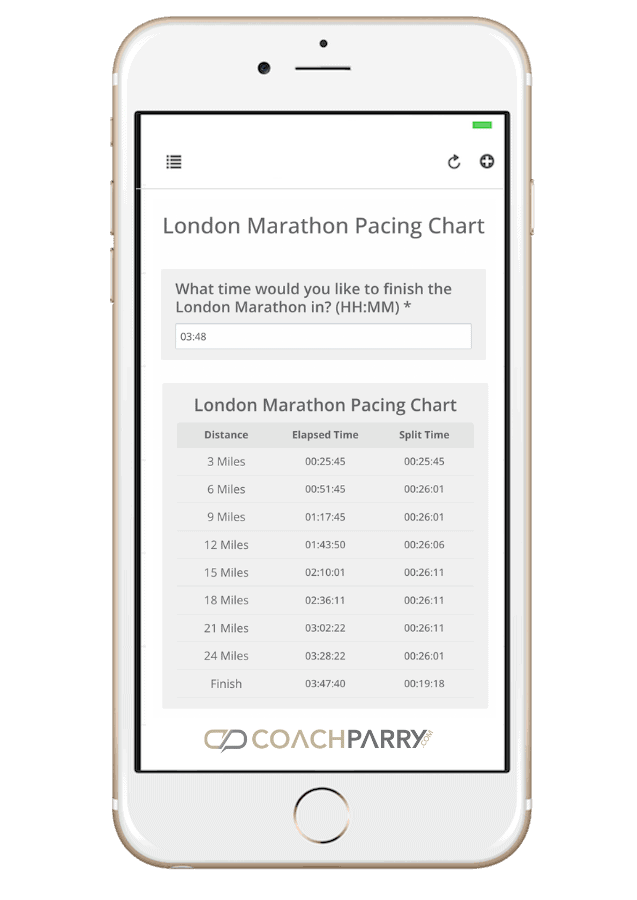What’s the secret to a perfectly paced London Marathon?
One word… Patience.
The word patience, realistic goal setting, and pacing play a big role on race day.
Pacing during your marathon is important because if you go out too hard from the start line… which is very easy to do as one gets caught up in all the race excitement… you could injure yourself and have to run in pain for what could be hours.
In this article, we are going to focus on working off of an accurate pacing chart… You need to be able to find a pacing chart based on what’s possible for you or not and then be patient and stick to that pacing chart.

Members of the Coach Parry Training Club get personalized help to calculate their pacing strategy. For the bigger races, we can make this race/route specific too.
A pacing chart or pacing band is like a road map to your end goal. You need to follow the directions and then you will eventually reach your final destination.
Let’s get started!

London Marathon Pacing Chart
Having a pacing plan going into the London Marathon is going to go a long way toward helping you achieve your goal.
It is however important to select the correct goal before calculating your pacing splits. Too often we see London Marathon runners who are capable of running a certain time, for example, a sub 4 hour, set out way too fast at a sub 3:45 pace because they want to ‘bank’ time for when they are fatigued later in the race.
We have created a London Marathon Pacing chart calculator that you can use to generate your pacing splits on race day, in either miles or kilometers, which will allow you to reach your goal.
This calculator takes into account the exact route profile for the London Marathon and calculates the splits per kilometer, depending on whether there is a net loss or gain in elevation.
Examples of London Marathon Pacing Charts
We’ve included a few pacing charts for a sub 5:00, sub 4:30, sub 4:00, and sub 3:30 London Marathon. You can generate your own, personal London Marathon pace chart by using our calculator (Click here to access it)
Sub-5 London Marathon Pacing Chart
| Distance | Elapsed Time | Split Time |
| 5km | 00:36:16 | 00:36:16 |
| 10km | 01:11:45 | 00:36:28 |
| 15km | 01:47:18 | 00:36:33 |
| 20km | 02:22:46 | 00:36:28 |
| 25km | 02:58:24 | 00:36:37 |
| 30km | 03:34:09 | 00:36:45 |
| 35km | 04:09:38 | 00:36:28 |
| 40km | 04:45:07 | 00:36:28 |
| Finish | 04:59:16 | 00:15:09 |
Sub 4:30 London Marathon Pacing Chart
| Distance | Elapsed Time | Split Time |
| 5km | 00:32:44 | 00:32:44 |
| 10km | 01:04:40 | 00:32:56 |
| 15km | 01:36:40 | 00:32:00 |
| 20km | 02:08:37 | 00:32:56 |
| 25km | 02:40:40 | 00:33:03 |
| 30km | 03:12:52 | 00:33:11 |
| 35km | 03:44:48 | 00:32:56 |
| 40km | 04:16:45 | 00:32:56 |
| Finish | 04:29:29 | 00:13:44 |
Sub 4-Hour London Marathon Pacing Chart
| Distance | Elapsed Time | Split Time |
| 5km | 00:29:13 | 00:29:13 |
| 10km | 00:57:36 | 00:29:23 |
| 15km | 01:26:03 | 00:29:27 |
| 20km | 01:54:27 | 00:29:23 |
| 25km | 02:22:57 | 00:29:30 |
| 30km | 02:51:34 | 00:29:37 |
| 35km | 03:19:58 | 00:29:23 |
| 40km | 03:48:21 | 00:29:23 |
| Finish | 03:59:40 | 00:12:19 |
Completing the London Marathon in under 4 hours is definitely achievable with the correct training plan, professional guidance, race day strategies, and mental strength to stay motivated throughout the entire process. Here’s all the guidance you need.
Sub 3:30 London Marathon Pacing Chart
| Distance | Elapsed Time | Split Time |
| 5km | 00:25:42 | 00:25:42 |
| 10km | 00:50:33 | 00:25:51 |
| 15km | 01:15:26 | 00:25:54 |
| 20km | 01:40:17 | 00:25:51 |
| 25km | 02:05:14 | 00:25:57 |
| 30km | 02:30:17 | 00:26:03 |
| 35km | 02:55:08 | 00:25:51 |
| 40km | 03:19:59 | 00:25:51 |
| Finish | 03:29:54 | 00:10:54 |
Tip: Completing the London Marathon in under 3 hours is a realistic goal for certain athletes. This is exactly how to train for the challenge.
If you have a specific time goal in mind, or if you’d like any of the above London Marathon pacing bands in miles, then click here to create your own.
Positive, Negative, and Even Splits
We’re big fans of negative splits. More often than not, if your training was good, you had a good taper leading up to the event, and you have a realistic goal in place, the chances of you doing an even split and possibly going negative toward the end are quite high.
A negative split would be a cherry on top, and an even split would be a perfectly executed race plan.
This is because if you start a race too hard and you lose speed towards the end, that’s when the process starts to control you.
But if you start slightly slower, more conservatively and you control the process all the way, I can guarantee you, the time lost by starting a slight bit slower compared to starting a bit too fast and then losing control of that process usually from about 36 kilometers, depending on how hard you went out.
Introducing:
The London Marathon Training Roadmap
What you do in the 12 weeks leading up to the London Marathon will either set you up for success or failure…
Ensure your success with 12 weeks of access to the Coach Parry London Marathon Training Roadmap
Let’s have a look at how pacing works in the London Marathon…
How Does Pacing Work In The London Marathon?
This is the rule of thumb way to calculate your London Marathon pace.
Typically to calculate it, I would use a 5km and a 10km and a half marathon time to try and determine if I’m improving as I’m running longer distances or if I’m getting better as I’m running longer and then I’ll make some slight tweaks.
Essentially, if you’re running 5km races fairly hard or you’ve got some decent 5km times, I think from a 5km to a 10km, you can be between 5 seconds (if you’re very conditioned) and 8 or 9 seconds per km slower, you’ll be able to hold for a 10km.

Then you will be in the region of 12-13 seconds per kilometer slower when you then move from that 10km to the 21km and then from the 21km to the marathon, you’re probably also looking around 8-10 minutes slower in a very conditioned person or somebody who gets relatively better as time goes by, you’re probably looking at about eight seconds per km slower, up to around 15 seconds per kilometer.
Obviously, if you’re someone who struggles and gets slower as you run longer, then you’re probably looking at more along the lines of around 17 seconds slower per kilometer and you need to work on your aerobic capacity.
Bearing in mind that the shorter the distance you’re using to predict, the more guessing is going on in-between steps.
The best place to guess from is your best half marathon and then somewhere in the region of 8K’s if you’re extremely fit and get better with distance and about 15 seconds per kilometer would be your normal drift off.
Having these calculations on what you should be running your marathon is important. Yes, there’s a bit of variation if you don’t have a 21km time if you’re working it on your 5km time, but having these things and making sure that you stick to them is important if you’re going to achieve the London marathon goal you set out to achieve.
What you need to do is, if you’re not dealing with extreme environments, like very cold or extremely hot, then you want to approach a marathon in a fairly even-paced time.
Aiming to be at halfway no more than one and a half to two minutes faster in the first half than you intend to run the entire race that is why it’s important to stick to your plan because at the beginning of the marathon, you can feel extremely fresh and feel like it’s your day and you push it hard and then all of a sudden somewhere between 21km or 13 miles and 16 miles or 25km, that’s when you start to feel, oh-oh, I’ve overdone it and you’ve still got quite a lot of race left to go.
The thing with a marathon is that there is always going to be a part where you “hit the wall”. For most people that tend to be at 24-26kms and so the goal is to train the aerobic system well enough to keep pushing that “wall” later in the race…
In the London marathon, the last three miles or 5km are telling and we can lose 30 seconds to a minute per km easily if our legs have taken a hammering.
You can never put enough time in the bag by going out too hard to save more than you’ll lose in the second half.
You’ll always lose more in the second half than intended if you go out with that sort of strategy.
That’s why It’s important to get the pacing right.
To get the pacing right, we recommend following a pacing chart like the one we shared above.

Does The London Marathon Have Pace Setters?
The London Marathon does have pace setters, they play a key role in helping you conquer the marathon in your time goal.
The London Marathon pacers who can be found by spotting a flag on their backs are experienced runners who complete the course at a managed pace and finish within a certain, predesignated time. They do this to lead other participants to finish at the same predesignated time.
How Far Do The Pacers Run In The London Marathon?
On the London Marathon race day, there are plenty of pacers around who kick off on the Red, Green, and Blue starting lines. (The pacers will carry flags bearing the color of the starter they began at)
For the masses of participants, the London marathon pacers run the entire route and lead their groups of runners across the finish time in their set time.
For elite participants, the pacers will only run up to a certain distance, and then for the rest of the route, it’s up to the elite runners to pace themselves.
Let’s find out if you’re going to be running below or above the average pace of the London Marathon…
What Is The Average Pace For The London Marathon?
According to Marathon Statistics 2019 Worldwide, including 19,614,975 marathon results in 32,335 races worldwide:
- Participation in marathons grew by 49.43% in the ten years from 2008 to 2018.
- The average marathon time worldwide is 4:29:53.
Based on the 2019 London Marathon, The Mirror states that the average finishing time for females was 4 hours 23 minutes and for males 3 hours 48 minutes.
How To Stick To Your London Marathon Splits
Pacing is all about how well you can distribute your body’s energy throughout the entire marathon. The main purpose of pacing is to ensure that you preserve enough energy needed to complete the race and finish strong.
Getting the pace right is a question of matching your expectations to your level of training.
In addition to pacing, understanding the London Marathon route is also vital in your preparation for race day, that’s why we’ve put together a detailed route breakdown just for you.



Comments are closed.